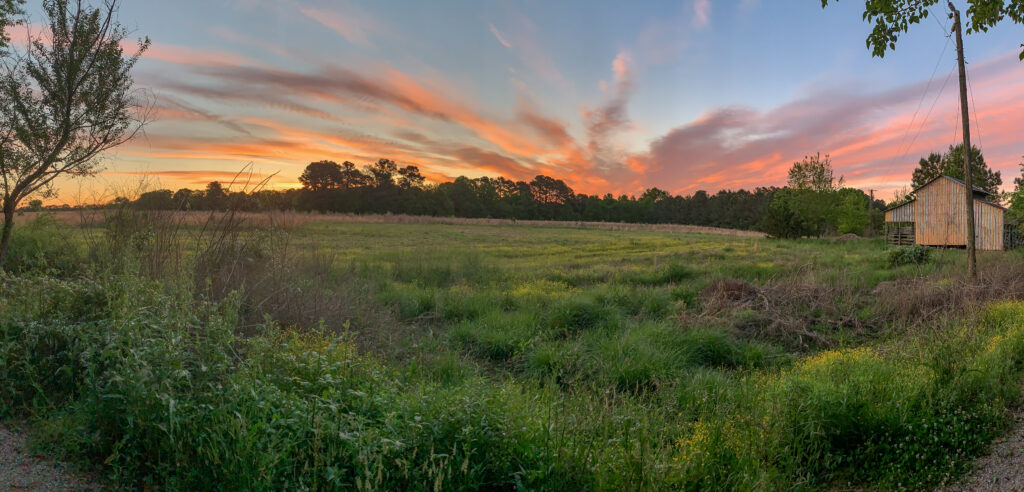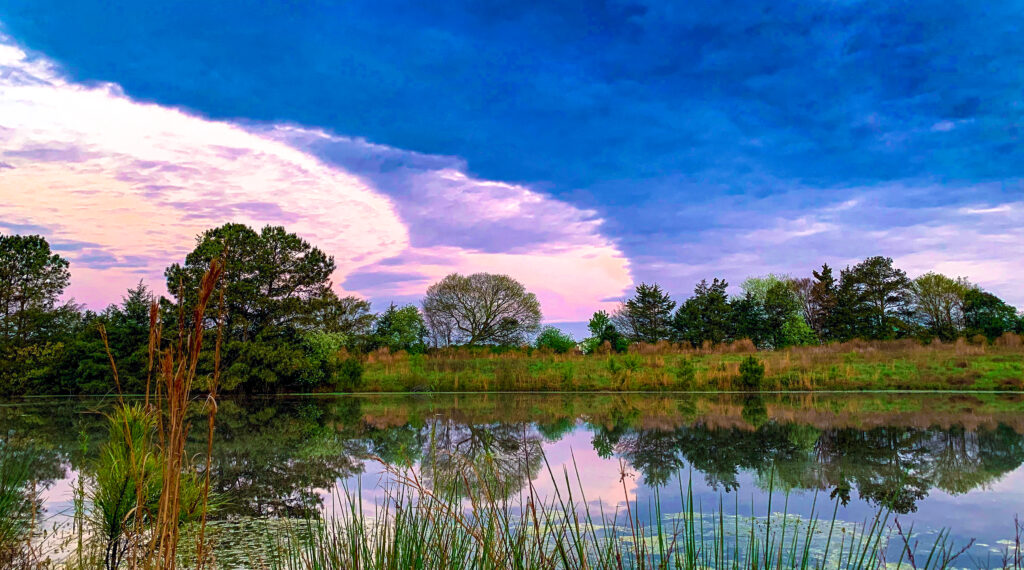By Dr. Rachel Damiani

TLC’s Brumley and Williamson Preserves host an estimated 60,000 visitors per year who embrace opportunities to walk, bike, and bird watching. But these preserves have not always been bustling with people. Only 10 years ago, each had just a few visitors, mostly family members who owned the land, a few farmers, and their friends.
“It’s harder than you’d think to turn farms and forests into public preserves that inspire people with natural beauty, safeguard clean water, protect natural habitats, and support local farms and food,” said Sandy Sweitzer, TLC’s Executive Director.
To accomplish this transformation, TLC puts together a funding puzzle for land protection, made up of a variety of public and private funders and generous contributions from landowners.
Purchasing the Land–A Giant Puzzle
The hardest and most complicated part of protecting these two properties was finding sufficient funds to acquire the land. Brumley was valued at almost $9 million and Williamson at $7 million at the time of the transactions.
Putting the land protection puzzle together doesn’t happen overnight or with a single funder. Rather, TLC began conversations about the vision for these properties with the landowners in the ‘90s. Once the landowners agreed to consider a sale and to donate a portion of the value, TLC staff submitted a variety of county, state, and federal grant applications.
“Brumley and Williamson were our first big projects that combined many different funding sources,” said Leigh Ann Hammerbacher, TLC’s Director of Land Protection and Stewardship (East). The generosity of the landowners was the first piece of the puzzle and catalyzed land protection. TLC was able to purchase what is now Brumley Preserve in part thanks to owners George and Julia Brumley’s commitment to conservation. The Brumleys initially purchased this property in the late ‘90s to protect it from development. After George and Julia’s tragic deaths from a plane crash in Kenya, the Zeist Foundation donated almost half of the land’s value.
The purchase and protection of Williamson Preserve was feasible partly due to a sizable donation from the family. Owners Sarah and Bailey Williamson hoped their farm would become a public preserve.
Remembering the Preserves’ Histories
By TLC staff
Bringing to the forefront the longer history of both preserves’ pasts provides an important context for understanding this intricate puzzle of funding land protection. Williamson and Brumley Preserves’ histories—what is known of them—follow a familiar Pre-Colonial Era path. It is suspected that both properties were once occupied by Indigenous communities, including the Eno, Lumbee, Occaneechi, Saponi, and Shakori people at Brumley Preserve, and the Tuscarora and Lumbee at Williamson Preserve.
Indigenous communities lived on and used these lands for sustenance or moved across the area as they journeyed to another location until white colonists took the land from them. During this time, the land that is now Williamson and Brumley Preserves was “given” to White families by the King. Across generations, these families forced enslaved Black people to work the land. After the Civil War, the land now known as Williamson Preserve was part of
a family farm in a community where Black and White people owned land and farmed alongside one another.
Understanding the deeper connection the land holds in the community, TLC collaborates with a diverse
set of partners—leveraging many funding sources— incorporating them into land stewardship.
After both had passed, their daughters, Sally Williamson Greaser, and Betty Brandt Williamson donated more than 60% of the land’s value to TLC.
The remaining funding for purchasing each preserve came from a variety of public and private funds. The puzzle pieces TLC staff put together to protect Brumley included NC Land and Water Fund (NCLWF, which was previously known as the Clean Water Management Trust Fund), Raleigh’s Watershed Protection Program (previously known as the Upper Neuse Clean Water Initiative), and private donations to TLC’s Our Water Our Land campaign.
For Williamson Preserve, TLC leveraged the landowners’ donation with funding from Wake County Open Space Bonds, NCLWF, Johnston County, and the State’s Environmental Enhancement Grant Program.
An important puzzle piece for both preserves and many other TLC projects was the NCLWF. This funding is provided by the NC State Legislature and supports land and water protection across the state. While NCLWF funding was slashed after the 2008 economic downturn, thanks to bipartisan support, the Fund has surged to $60 million in the 2021 budget. This budget increase will support important land protection efforts across the state, including in the Triangle. TLC currently has 9 proposals to protect more than 1,100 acres pending with NCLWF.
In addition to state funding, county funding also plays a crucial role in land acquisition. For example, TLC received funding from Orange County and Raleigh’s Watershed Protection Program, which helped purchase the original 613-acre Brumley tract in 2010, and to protect 60 additional acres to expand the preserve in 2019. At Williamson, both Wake and Johnston Counties made significant contributions to aid in land acquisition. These public funds work together with one another and with private donations to TLC to make these land protection projects possible. Bo Howes, TLC’s Director of Land Protection and Stewardship (West) explained that many of these funding sources require matching funds.
“Sometimes they require a dollar-for-dollar match, sometimes less, often the match can be a combination of labor or cash,” he said. For example, membership and other donations to TLC leverage each grant. Private donations, including those made during TLC’s Our Water, Our Land campaign, often serve as one source of matching funds. In addition, some private donations ignite conservation. For example, TLC’s Catalyst Fund, which was established in 2018 by the Salamander Fund of Triangle Community Foundation and added to by other private donors, was a key source for ensuring TLC could acquire the Brumley Expansion.
“Sometimes state funding takes a while to be approved or is put on pause after it’s been approved,” Hammerbacher said. “So, with the Catalyst and Land Opportunity Funds, TLC can close on a project before we have the funding in hand.” This is exactly what happened with both Brumley and Williamson in 2008 when the State committed the funds, but then delayed releasing them during the recession. TLC used its own Land Opportunity Fund to close the projects and then paid back the fund when the state released their grants.
This example illustrates how the puzzle of land protection hinges not only on the appropriate funding sources coming together but also on the timing and availability of these funds. This timing piece is becoming an increasingly important factor as the Triangle area experiences rapid growth and development. TLC’s flexible reserves of funding facilitate TLC’s ability to act quickly to protect the land. Without private funds, the community might not be enjoying these preserves today.
Preparing the Preserve for Public Use, from Trails to Parking Lots
After TLC acquires properties that will be open to the public, the next step, according to Hammerbacher and Howes, is to prepare and implement a plan for public use, including designing and constructing sustainable trails and beginning habitat restoration. Planning is a key aspect of land preparation to ensure TLC’s efforts align with the overarching vision for the preserves.
For example, one of the goals at Williamson was to support farming efforts, including regenerative farming. Over several years, TLC worked closely with a variety of stakeholders, including community members and the Walnut Hill Advisory Committee, to develop a detailed Agricultural Concept Plan. During the implementation stage, TLC partnered with Wake County for their NextGen Farm Initiative to hire a Farm Coordinator, and with NC State’s Center for Environmental Farming Systems to support the farmers. In addition, both Williamson and Brumley needed sustainable trail systems for public use. TLC received three grants from the State’s Recreational Trail Program to design and construct 30 miles of trails (15 at each). These grants require matching funds and volunteer hours, which were provided by Triangle Off Road Cyclists, individuals, TLC’s Conservation Corps, REI, and Johnston County. Howes emphasized that volunteer efforts are an invaluable asset in the puzzle of land protection.
“The sweat equity of our volunteers is a vital component for both opening and maintaining our preserves,” Howes said. Volunteers assist with many other land stewardship tasks, including invasive species removal and tree planting.
With the trails constructed, signage, and parking lots installed, the preserves were ready for public use. Brumley opened in 2017 and Williamson in 2020. “Getting out on the site and seeing the diversity of users—both human and wildlife —seeing so many people connecting with and enjoying nature is the most rewarding part for me,” Hammerbacher said.

Land Protection is Greater than the Sum of its Parts
Hammerbacher and Howes express that being a part of this puzzle of funding land protection is both inspiring and meaningful to them. Howes said he is motivated by the commitment and support of such a diverse group of funders who are willing to invest in these preserves. “It’s a real validation about what we’re doing,” he said.
TLC staff are also inspired by knowing that land protection efforts have a cumulative and synergistic impact. Protecting Stony Creek at Brumley not only benefits this preserve’s water and wildlife habitat, but also helps provide clean drinking water for residents across the Triangle, including residents of Raleigh, Wendell, and Clayton, all of whom draw their drinking water from the Neuse Watershed.
Expanding regenerative agriculture efforts at Williamson not only supports local farmers but also provides local food to the community.
“Even if someone never steps foot on a preserve, there are so many benefits beyond just the immediate recreation for these lands –– the wildlife corridors they’re protecting, the water quality and the water they’re drinking,” Hammerbacher said. “They’re permanently protected. They’re helping create a legacy in the Triangle that will be here for generations to come.”
The funders who make this legacy possible have a combined impact that is greater than the sum of their parts. Because TLC can leverage one fund to fulfill the matching requirements of another, each dollar helps TLC raise another dollar for land protection. In this way, these funders help TLC put together the puzzle to conserving 25,000 acres by 2025.
